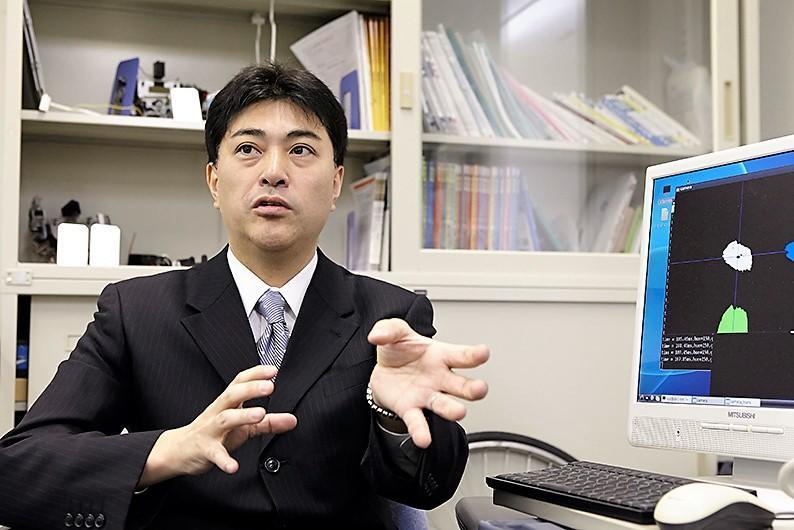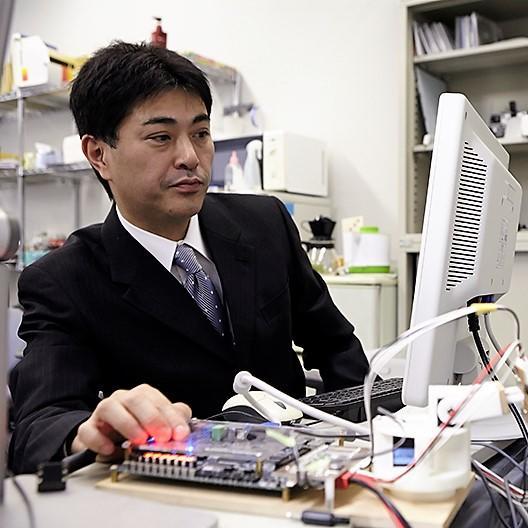- TOP
- Cutting-edge Research and Social Contribution
- Cutting-edge Research
- Realization of near-human systems based on a flexible human intelligence model

Realization of near-human systems based on a flexible human intelligence model

HOSHINO Yukinobu
- Specialized field
Intelligent systems, Machine learning, Affective engineering, Human interface
Combining artificial intelligence and FPGA for smaller, faster systems
In recent years, artificial intelligence (AI) research has advanced rapidly, and examples of its application are seen in every field. Associate Professor Hoshino has been conducting research on computer systems that operate flexibly, in a manner closer to that of human beings.
He explains, "We are doing research that replicates human abilities on a computer and uses them in various control devices, such as algorithms or tools for supporting people. Examples of such applications include robots that can move under the control of human thought, cars that can drive autonomously (as if people were driving them) and friendly interfaces that harmonize with human feelings and senses. We are aiming at the creation of an artificial brain modeled on flexible human intelligence, stored in a compact system in one chip."
As computer performance has evolved, the capacity of semiconductor memory, indispensable for personal computers and smartphones, has increased and processing speed has improved. Artificial intelligence applications used to be limited to simple processing, but now AI can be applied to a variety of tasks, such as processing images containing a lot of data.
Meanwhile, systems using AI are essential to real-time performance, and field-programmable gate arrays (FPGA) capable of faster processing than CPU are attracting considerable research attention nowadays. FPGAs, programmable semiconductors, have the advantage that all complicated processing capabilities can be integrated into one chip. Dr. Hoshino is one of the few researchers in Japan conducting research on the combination of artificial intelligence and FPGA.
He says, "Utilization of FPGA is now a global trend in the field of artificial intelligence, which demands high speed and miniaturization. I think that it is a major strength of Japan that we are leading this area of research."
Efficient analysis of immune cell macrophages with an AI-based automatic tracking system
Currently, Dr. Hoshino is collaborating with Kochi University's School of Medicine to develop a tool to support the analysis of macrophages present in certain kinds of tissue. Macrophages are indispensable for human health: they catch foreign substances that have invaded the body, then disassemble and absorb them. In the medical field, vigorous research is exploring the degree to which a person's health condition affects macrophage function.
"It is said that there is a relationship between macrophage movement and immunity, so we have been working to apply AI to the analysis of variations in macrophage movement, to develop means of supporting medical treatment," he comments.
However, since macrophages constantly deform and overlap with other cells, it is difficult to follow their movements using ordinary image processing. In fact, that kind of analysis involves extracting still images from video images of human cells frame by frame and checking each macrophage motion one by one, which takes a tremendous amount of time and effort.
To overcome those limitations, Dr. Hoshino and his team developed an innovative tool to automate a series of analysis tasks using AI. With this tool, it is possible to trace macrophage movement while automatically observing deformations in the shape of macrophages. Dr. Hoshino explains, "We realized that using AI we can do tasks which previously could only be done by human manual labor. Now in only five minutes we can complete work that used to take months."
The team will ask physicians to use this tool in practice and give feedback for improving its tracking performance.
Resolving regional issues with object detection technology
Object detection technology has many applications, including image retrieval, face recognition and vision support. Lately research on object detection has been responding to the increase in the volume of image data owned by individuals, particularly regarding improvement of computer processing speed. Dr. Hoshino is also pursuing research to advance that technology.
"When the volume of images becomes enormous, there is a need to be able to detect various patterns among those objects, for example: to identify images that contain human figures; to recognize coarse images; and to perform gender identification. To develop recognition systems that can identify all kinds of patterns, we are conducting trial and error research to create an AI mechanism for searching huge data using FPGA technology."
Those efforts have led to the successful creation of a tool for identifying handwritten characters, which involve an enormous volume of deformed patterns. Now Dr. Hoshino and his team are working to improve the accuracy of classification of images containing figures such as people, dogs and airplanes and to realize high speed, large capacity FPGA hardware using that capability.
"If this research is successful, we will be able to authenticate identity by means of such features as retina, face and capillary pattern. If an individual registers his/her body features, authentication may become so reliable that there will no longer be a need for ID cards. I have a feeling that this may be realized in the not too distant future."
Furthermore, AI-based object detection technology can be also used to address some issues unique to hilly areas in rural Japan. Lately in those areas, damage by wild monkeys coming down from the mountains has been increasing. In order to solve this problem, Dr. Hoshino and his team are constructing a mechanism to attract monkeys into big cages and capture them. Where does AI come into play in this mechanism?
"AI is used to determine whether the animal in the cage is a monkey or not. When the system detects the presence of a monkey in the cage, the operator gets a message and closes the door by remote control."
AI has found wider and wider applications, from analysis of human cells to solution of regional problems. It's thought that the ultimate evolution of AI technology could be a brain-computer interface, a system that controls external equipment by detecting the intention of the human subject by measuring brain activity. This has been drawing considerable research attention, as it can be used as an alternative means of communication for people with limited physical function, for example patients with severe quadriplegic paralysis as a result of accidents such as spinal cord injury.
In the United States, advanced research in this field has been focused on a surgical method for implanting electrodes in the brain, but this involves high risk. Dr. Hoshino is working to develop a non-surgical mechanism: detecting the signal from the surface of the brain that indicates that a person has initiated thought, and using such signals for communication. So far Dr. Hoshino and his team have succeeded in detecting signals generated in the frontal lobe of the brain when a person thinks of something. This is a promising step.
Dr. Hoshino is optimistic about the future of AI research. He says, "If the field of artificial intelligence can make further advances and can demonstrate the ability to generate intelligence equal to or higher than that of human beings, machines and robots that support human beings will become common. Perhaps robots may eventually be able to act as partners for people. Through this research, we are working towards a kind of dream-like future."
